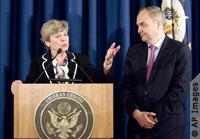Women Lead US Nuclear Negotiating Team
 When Rose Gottemoeller
began negotiating the new nuclear treaty with Moscow, the U.S. diplomat
got questions on the usual topics: missile defense, warheads,
inspections.
When Rose Gottemoeller
began negotiating the new nuclear treaty with Moscow, the U.S. diplomat
got questions on the usual topics: missile defense, warheads,
inspections.
And then there was this one from the Russian generals: "How come you've got so many women?"
To the Russians' astonishment, an array of American women faced them across the negotiating table. Gottemoeller led the American team during the negotiations, which concluded in March. Her deputy was Marcie Ries, another diplomat. The top two U.S. scientists were female. And helping to close the deal on the New START agreement was Ellen O. Tauscher, a State Department undersecretary and former congresswoman.
The U.S. delegation reflected a little-noticed shift in the tough-guy world of national security. Twenty-five years after White House aide Donald Regan famously opined that women were "not going to understand throw-weights," American females clearly get nuclear policy.
They also run it.
Or a lot of it, anyway. Women hold senior nuclear positions at the Pentagon and White House. Search out the old office of Gen. Leslie R. Groves, the Manhattan Project's "Indispensable Man," and you will find a woman. She is Karin Look, who helped oversee the dismantling of Libya's nuclear weapons program.
"From me to the secretary, it's all female," said Look, a senior verification official whose chain of command extends up to Secretary of State Hillary Rodham Clinton.
The nuclear experts are indicative of an expanding cast of top female national security officials. Women occupy between 21 and 29 percent of the senior positions at the State Department, USAID, the Pentagon and other national security and foreign policy agencies, according to a recent survey by Women in International Security, a professional group. About 13 percent of the Senior Intelligence Service is female, it found.
"We're really at a very critical juncture in the field at large. We've had many more women than we've ever seen," said Jolynn Shoemaker, executive director of the group. "It's particularly visible in this administration."
Current and former officials say the increase is not just due to the Obama administration. Gradually, the women who began taking national security jobs in the military, the diplomatic service, think tanks and other institutions in the 1970s and 1980s are rising to the top.
They include people such as Michele Flournoy, the Defense Department's undersecretary for policy and one of the highest-ranking women in Pentagon history; Letitia A. Long, who recently was named to run the National Geospatial-Intelligence Agency; and Laura Holgate, a top nuclear official with the National Security Council.
"We're not overnight successes," said Susan Burk, a 34-year government employee and the top U.S. official at the recent review of the nuclear Non-Proliferation Treaty. Perhaps "we have to work more years to get to these positions."
Click here to read the full story:
By Mary Beth Sheridan
The Washington Post